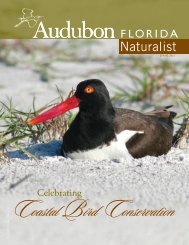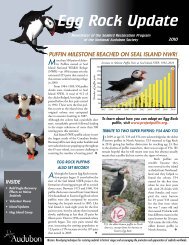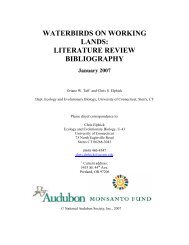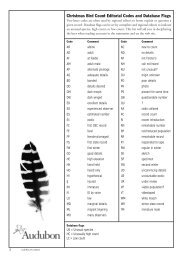Full report [PDF] - the Boreal Songbird Initiative
Full report [PDF] - the Boreal Songbird Initiative
Full report [PDF] - the Boreal Songbird Initiative
Create successful ePaper yourself
Turn your PDF publications into a flip-book with our unique Google optimized e-Paper software.
Swamp SparrowPhoto/Mary Kay RubeyThe <strong>Boreal</strong> Forest Region:North America’s Bird NurseryPeter BlancherCanadian Wildlife ServiceNational Wildlife Research Centre, Carleton University, Raven Road,Ottawa, ON, K1A 0H3; Peter.Blancher@ec.gc.caJeffrey Wells<strong>Boreal</strong> <strong>Songbird</strong> <strong>Initiative</strong> Suite 615, 1601 Second Avenue, Seattle, WA 98101; jeffwells@borealbirds.orgThe <strong>Boreal</strong> Forest Region of North America, stretching from Alaska across 6,000kilometers (3,500 miles) to Newfoundland and Labrador, at 5.9 million square kilometers(1.5 billion acres), is <strong>the</strong> largest wilderness left in North America and represents25 percent of <strong>the</strong> world’s remaining intact forests (CBI 2005). Its vastness also makesit one of <strong>the</strong> few remaining places on earth where entire ecosystems function. Theseecosystems support some of <strong>the</strong> greatest abundance of wildlife on <strong>the</strong> continent,including massive caribou herds, intact predator-prey systems with healthy populationsof top predators like wolves, and large numbers of birds (Ricketts et al. 1999).This <strong>report</strong> was originally published inApril 2005. The study was commissionedby <strong>the</strong> <strong>Boreal</strong> <strong>Songbird</strong> <strong>Initiative</strong> and <strong>the</strong>Canadian <strong>Boreal</strong> <strong>Initiative</strong>.While all this has been known aboutNorth America’s <strong>Boreal</strong> Forest Region,its importance has sometimes been overlookedprecisely because of its abundantwildlife. Most global level conservationassessments of large ecoregions havefocused on <strong>the</strong> number of differentspecies of animals and plants (Karievaand Marvier 2003). Areas with a highnumber of different species tend to bePeter Blancher, Ph.D., recently returned to Environment Canada’s Canadian Wildlife Service after four years as Partners in Flight (PIF) Scientist with Bird StudiesCanada. He continues to provide technical support for landbird conservation planning at continental, national, and regional scales. As a member of <strong>the</strong> PIF ScienceCommittee, he is a co-author of <strong>the</strong> Partners in Flight North American Landbird Conservation Plan.Jeffrey Wells, Ph.D., is <strong>the</strong> senior scientist for <strong>the</strong> <strong>Boreal</strong> <strong>Songbird</strong> <strong>Initiative</strong>. He was a senior scientist with <strong>the</strong> Cornell Lab of Ornithology and served as Audubon’sNational Bird Conservation Director for many years. He has published more than 100 academic papers, technical <strong>report</strong>s, and popular articles about birds andbird conservation.30 AMERICAN BIRDS


![Full report [PDF] - the Boreal Songbird Initiative](https://img.yumpu.com/52893853/3/500x640/full-report-pdf-the-boreal-songbird-initiative.jpg)







